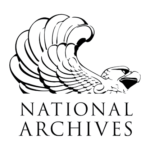Award Activity

2022-2023 Fulbright-National Archives Heritage Science Fellow, Cancy Chu, working at Heritage Science Lab.Read more.
Heritage scientists work closely with other conservation and preservation experts at NARA on a wide range of materials found in our archives. Here paper conservation colleagues work on a large poster.
The selected Fellow will work in the Heritage Science Research and Testing Laboratory of the National Archives and Records Administration, a facility focused on scientific research to assist in the conservation, preservation, and ongoing public accessibility of cultural and historic artifacts, records, and documents.
The Fellow will work with a team of heritage science experts and get hands-on laboratory experience. Scientists work collaboratively with a variety of units within the archives and with other Washington, D.C.-area universities and government agency partners on a diverse range of projects that leverage their expertise in analytical chemistry, physics, computational modeling and materials science. The National Archives collection includes materials ranging from paper and parchment to photographs, modern film, magnetic audio/visual tapes and digital files. Increasing knowledge about the collections and how to reduce the risks of damage and loss are the inspiration for research projects.

2023-24 Fulbright-National Archives Fellow, Laís Feltrin Sidou, at work in the laboratory. Read more.
Scientists are also active in professional organizations and regularly present and publish work that benefits the heritage science community. The Fellow will be encouraged to participate by presenting their progress, collaborating on publications, and building peer networks.
Strong applicants will be emerging or established experts in scientific and technical fields relevant to heritage preservation and conservation, with projects that align with the work and goals of the National Archives and Records Administration Heritage Science Research and Testing Laboratory. High quality projects will contribute to international collaborations in heritage science, and build relationships with U.S. experts and institutions. Current project interests include:
- managing the effects of temperature, humidity, light, and other factors,
- testing new conservation treatment methods and tools,
- polymer characterization and aging.
Award Details
Location
The National Archives and Record Administration Heritage Science Research and Testing Lab is located just outside of Washington, D.C. in College Park, Maryland. The Lab will provide the Fellow with needed office and bench space and access to common wet lab supplies, PPE, and equipment, including a desktop computer. The lab also has several analytical instruments available including an XRF, FT-IR, and GC/MS. The lab houses several temperature and humidity controlled ovens and a microfadometer often used for material aging experiments.
The National Archives and Records Administration (NARA) is an independent agency of the United States government charged with the preservation and documentation of U.S. government and historical records. While NARA’s flagship locations are in the Washington, D.C. area, the agency represents a network of 40+ locations across the nation, including presidential libraries.
Grant Benefits
The selected participant will receive J-1 visa sponsorship, J-1 visa compliant health benefits, and round-trip international travel to the United States. The Fulbright visiting scholar will also receive a modest stipend to cover living expenses, settling in, and professional development allowances, and if applicable, a modest dependent allowance. J-visa compliant health insurance and travel costs for accompanying dependents are the responsibility of the participant. Additionally, recipients of this award will be invited to participate in Fulbright Scholar Enrichment Activities as well as Fulbright’s Outreach Lecturing Fund. Fellows will join a diverse, active, worldwide network of alumni who carry the impact of their transformational Fulbright experience far beyond the period of their exchange programs.
Award Length and Dates
Minimum of five (5) months, maximum of twelve (12) months beginning September 2026
Eligibility
Eligible candidates will be researchers or professionals in heritage science or related technical fields, and be a citizen of and resident in one of the following countries: Ghana, Indonesia, Italy, Jordan, Mexico, Morocco, Nigeria, Pakistan, Peru, Poland, Sri Lanka, or Taiwan. U.S. Citizens or U.S. permanent residents, including dual citizens, are ineligible for Fulbright Visiting Scholar Awards.
- A Master’s degree is required, but Ph.D. or equivalent professional experience is preferred. Advanced Doctoral researchers completing dissertation projects related to heritage science are eligible to apply.
- Past experience with heritage science or archival research is preferred, but not required.
Disciplines
- Heritage/Conservation Science
- Preventative Preservation
- Chemistry
- Physics
- Materials Science and Engineering
- Microbiology
- Statistics

Scientist using a handheld FTIR attachment to identify the plastic used to print this topographical map of a section of the moon
Areas of Interest
- Archival cultural heritage preservation and conservation
- Applications of technology to complex issues in heritage preservation and risk management
- Data analysis and visualization
Previous Grantees

2022-23: Cancy Chu – Australia
Ph.D. candidate at University of Melbourne’s Grimwade Centre for Cultural Materials Conservation
Interventive Materials and Techniques for the Repair of Synthetic Papers

2023-24: Laís Feltrin Sidou – Brazil
Ph.D. student in Social Memory and Cultural Heritage at the Federal University of Pelotas, Brazil
Sustainable Management of Modern and Contemporary Textile Heritage. Understanding Significance, (Un)acceptable Change and Modelling Future Impact in Textile Heritage Collections.

2024-25: Rasha Ahmed Elsaid Shaheen – Egypt
Senior Conservator at the Egyptian Museum in Cairo
Enhancing Nanomaterial Properties for the Preservation of (Black & White) Silver Gelatin Heritage Photographs
Questions
Application Deadline
The application for the 2026–2027 academic year will open on September 30, 2025, and the deadline is January 12, 2026, at 5 p.m. Eastern Time.
Webinars
Webinar Archives
View our recorded webinar recordings from past years’ competitions.











